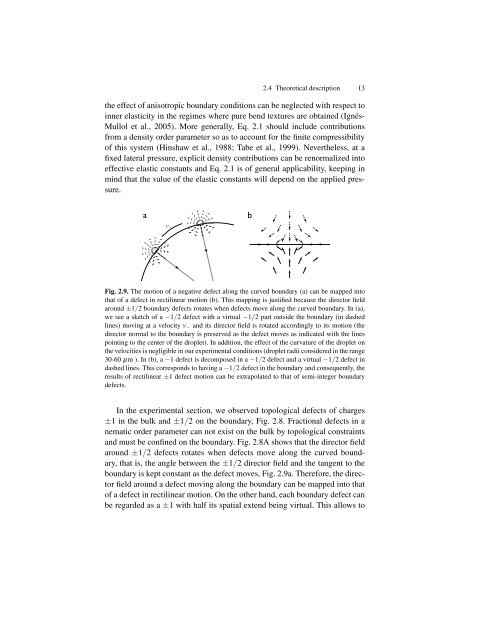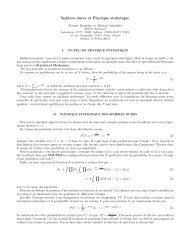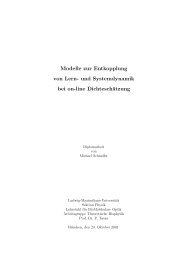Thesis (pdf) - Espci
Thesis (pdf) - Espci
Thesis (pdf) - Espci
Create successful ePaper yourself
Turn your PDF publications into a flip-book with our unique Google optimized e-Paper software.
2.4 Theoretical description 13<br />
the effect of anisotropic boundary conditions can be neglected with respect to<br />
inner elasticity in the regimes where pure bend textures are obtained (Ignés-<br />
Mullol et al., 2005). More generally, Eq. 2.1 should include contributions<br />
from a density order parameter so as to account for the finite compressibility<br />
of this system (Hinshaw et al., 1988; Tabe et al., 1999). Nevertheless, at a<br />
fixed lateral pressure, explicit density contributions can be renormalized into<br />
effective elastic constants and Eq. 2.1 is of general applicability, keeping in<br />
mind that the value of the elastic constants will depend on the applied pressure.<br />
a b<br />
v−<br />
Fig. 2.9. The motion of a negative defect along the curved boundary (a) can be mapped into<br />
that of a defect in rectilinear motion (b). This mapping is justified because the director field<br />
around ±1/2 boundary defects rotates when defects move along the curved boundary. In (a),<br />
we see a sketch of a −1/2 defect with a virtual −1/2 part outside the boundary (in dashed<br />
lines) moving at a velocity v− and its director field is rotated accordingly to its motion (the<br />
director normal to the boundary is preserved as the defect moves as indicated with the lines<br />
pointing to the center of the droplet). In addition, the effect of the curvature of the droplet on<br />
the velocities is negligible in our experimental conditions (droplet radii considered in the range<br />
30-60 µm ). In (b), a −1 defect is decomposed in a −1/2 defect and a virtual −1/2 defect in<br />
dashed lines. This corresponds to having a −1/2 defect in the boundary and consequently, the<br />
results of rectilinear ±1 defect motion can be extrapolated to that of semi-integer boundary<br />
defects.<br />
In the experimental section, we observed topological defects of charges<br />
±1 in the bulk and ±1/2 on the boundary, Fig. 2.8. Fractional defects in a<br />
nematic order parameter can not exist on the bulk by topological constraints<br />
and must be confined on the boundary. Fig. 2.8A shows that the director field<br />
around ±1/2 defects rotates when defects move along the curved boundary,<br />
that is, the angle between the ±1/2 director field and the tangent to the<br />
boundary is kept constant as the defect moves, Fig. 2.9a. Therefore, the director<br />
field around a defect moving along the boundary can be mapped into that<br />
of a defect in rectilinear motion. On the other hand, each boundary defect can<br />
be regarded as a ±1 with half its spatial extend being virtual. This allows to




